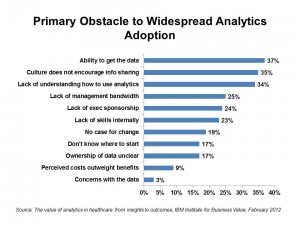 The ability to get the data is the #1 obstacle that will slow the adoption of data analytics in health care, according to IBM’s report, The value of analytics in healthcare: from insights to outcomes.
The ability to get the data is the #1 obstacle that will slow the adoption of data analytics in health care, according to IBM’s report, The value of analytics in healthcare: from insights to outcomes.
Healthcare “high performers,” as IBM calls them, use data analytics for guiding future strategy, product research and development, and sales and marketing functions. 90% of healthcare CIOs told IBM that developing “insight and intelligence” were key focuses of their organizations over the next 3 to 5 years.
Underneath this macro objective are 3 business goals that data analytics addresses in healthcare: to improve clinical effectiveness and patient satisfaction; to improve operational effectiveness; and, to improve financial and administrative performance.
Data analytics is seen as a crucial competence for health care organizations to master on several fronts:
- – Analyzing Big Data can help health providers better manage patients’ utilization of services, improve outcomes and drive waste out of inefficient processes; and,
– Analytics can streamline and improve the process of scientific discovery, bringing novel therapies to market faster and targeting patients who can best benefit from them, among other benefits to the health system.
What data analytics does is “consume, unlock and apply new insights from information,” IBM writes. It’s the “unlocking” that’s the biggest challenge in the healthcare vertical: IBM found that organizational barriers plague healthcare organizations who are trying to get at data, but cannot. Cultures that do not encouraging sharing information exacerbate this problem — not data standards or lack of having enough data. An aspect of this is the issue of who owns the data and data governance. There are plenty of data points in healthcare: the metaphor of “unlocking” is spot-on.
Another substantial problem was coined by one health system CIO interviewed by IBM who said, “Our executives don’t know how bad the data is.” Thus data quality and integrity, once “unlocked,” could compromise the analytics and insights drawn from the information. Trustworthiness of the data, and timeliness, will help ensure quality outcomes in healthcare data analytics.
Health Populi’s Hot Points: IBM offers a 5-step paradigm for helping health organizations get value out of data analytics:
- Focus on the biggest and highest value opportunities
- Start with questions, not data
- Embed insights to drive actions and deliver value
- Keep existing capabilities while building new ones
- Use an information agenda to plan the future.
I’d like to emphasize the first, second and last issues. First, the low-hanging fruit — it doesn’t take major Big Data projects akin to something the defense or airline industry would take on to make a big difference at the margins of health care economics. The utilization management opportunity, for example, can hone in on the small percent of patients who consume the largest percentage of resources. The time is now for hospital, especially, to move ahead with such programs to prevent readmissions for patients discharge with acute myocardial infarction, congestive heart failure, and pneumonia, among other targeted illnesses. Combining data analytics to hone in on these patients, along with discharging them home with remote monitoring technologies and case management, can move the needle on the individual hospital’s outcomes and patient satisfaction — while driving costs down and efficiencies up.
The second topic is starting with questions, not data. This is cart-before-horse time. Diving into data without “measuring twice, and cutting once” in terms of thinking through Big Management Questions is a waste of resources. But spending time to scope out hypotheses to test that deal with challenging operational and strategic issues is a wise way to spend time, up-front. Healthcare needs to get away from the “ready, fire, aim” approach, and spend more time on the readying and aiming.
Finally, the information agenda: I’m counseling virtually all my clients today, whether in consumer-facing industries such as food and retail pharmacy, to B2B technology companies and pharma, to understand the value of data and how to migrate their organizations toward a culture of health information — and the infrastructure required to get ‘there.’ I say “migration” and I mean “migration.” This is a journey, not a destination: organizations can grow in sophistication with their clients, but take the steps together to use, hone and constantly refine how data can be used to benefit patients, the public, and the health organizations who serve them.




 Interviewed live on BNN Bloomberg (Canada) on the market for GLP-1 drugs for weight loss and their impact on both the health care system and consumer goods and services -- notably, food, nutrition, retail health, gyms, and other sectors.
Interviewed live on BNN Bloomberg (Canada) on the market for GLP-1 drugs for weight loss and their impact on both the health care system and consumer goods and services -- notably, food, nutrition, retail health, gyms, and other sectors. Thank you, Feedspot, for
Thank you, Feedspot, for  As you may know, I have been splitting work- and living-time between the U.S. and the E.U., most recently living in and working from Brussels. In the month of September 2024, I'll be splitting time between London and other parts of the U.K., and Italy where I'll be working with clients on consumer health, self-care and home care focused on food-as-medicine, digital health, business and scenario planning for the future...
As you may know, I have been splitting work- and living-time between the U.S. and the E.U., most recently living in and working from Brussels. In the month of September 2024, I'll be splitting time between London and other parts of the U.K., and Italy where I'll be working with clients on consumer health, self-care and home care focused on food-as-medicine, digital health, business and scenario planning for the future...